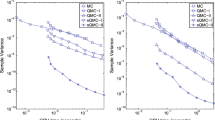Abstract
A model to price default free bonds, similar to ones developed by Cox, Ingersoll and Ross, Langetieg, and Richard, is empirically examined. Calculation of model prices involves three disjoint tasks: (1) estimation of the values of the real interest rate and the inflation rate (which we will refer to as state variables or sources of uncertainty) as well as the parameters of the state stochastic differential equations, (2) estimation of the market prices of risk associated with the two state variables, and (3) the solution of the valuation partial differential equation. Task 1 is accomplished by using a Kalman Filter algorithm, task 2 uses a Fama/MacBeth approach, and task 3 utilizes an Alternating Direction Implicit finite difference technique. Model prices are compared to actual prices. The model performs better during a period of relatively stable economic conditions compared to a period associated with more volatile conditions. Pricing errors are smaller at short maturities, and increase as time to maturity increases.
Similar content being viewed by others
References
A.L. Ananthanarayanan, Parameter estimation of stochastic interest rate models and applications to bond pricing, Dissertation, UBC (1978).
M. Brennan and E. Schwartz, A continuous time approach to the pricing of bonds, J. Banking Fin. 3 (1979) 133–155.
M. Brennan and E. Schwartz, Conditional predictions of bond prices and returns, J. Fin. 35 (1980) 405–417.
M. Brennan and E. Schwartz, An equilibrium model of bond pricing and a test of market efficiency, J. Fin. Quant. Anal. 17 (1982) 301–329.
S. Brown and P. Dybvig, The empirical implications of the Cox, Ingersoll, Ross theory of the term structure of interest ates, J. Fin. 41 (1986) 616–630.
J. Cox, J. Ingersoll and S. Ross, A theory of the term structure of interest rates, WP #468, University of Chicago (1978).
U. Dothan, On the term structure of interest rates, J. Fin. Econ. 6 (1978) 59–69.
E. Fama, Short term interest rates as predictors of inflation, Amer. Econ. Rev. 65 (1975) 269–282.
E. Fama, Inflation uncertainty and expected returns on Treasury bills, J. Political Econ. Rev. 84 (1976) 427–448.
E. Fama and M. Gibbons, Inflation, real returns, and capital investment, J. Monetary Econ. 9 (1982) 297–323.
K. Garbade and P. Wachtel, Time variation in the relationship between inflation and interest rates, J. Monetary Econ. 4 (1978) 755–765.
M. Granito and D. Nevins, Multifactor term structures for immunizing real returns, wp J.P. Morgan Investment Management (1987).
N. Gultekin and R. Rogalski, Government bond returns, measurement of interest rate risk, and the arbitrage pricing theory, J. Fin. 40 (1985) 43–61.
D. Heath, R. Jarrow and A. Morton, Bond pricing and the term structure of interest rates: A new methodology for contingent claims valuation, Econometrica 60 (1992) 77–106.
T.S. Ho and S. Lee, Term structure movements and pricing interest rate contingent claims, J. Fin. 41 (1986) 1011–1028.
T. Langetieg, A multivariate model of the term structure of interest rates, J. Fin. 35 (1980) 71–97.
F. Longstaff and E. Schwartz, Interest rate volatility and the term structure: A two factor general equilibrium model, Working Paper, Ohio State University (1991).
J.P. Ogden, An empirical test of a continuous time arbitrage pricing model for default free bonds, Dissertation, Purdue (1982).
D.W. Peaceman and H.H. Ratchford, The numerical solution of parabolic and elliptic differential equations, SIAM J. 3 (1955) 28–41.
S. Richard, An arbitrage model of the term structure of interest rates, J. Fin. Econ. 6 (1978) 33–57.
R. Stambaugh, The information in forward rates: Implications for models of the term structure, J. Fin. Econ. 21 (1988) 41–70.
Author information
Authors and Affiliations
Rights and permissions
About this article
Cite this article
Weeks, D., Kassicieh, S. Using kalman filter and finite difference techniques in default free bond pricing models. Ann Oper Res 45, 405–431 (1993). https://doi.org/10.1007/BF02282061
Issue Date:
DOI: https://doi.org/10.1007/BF02282061




